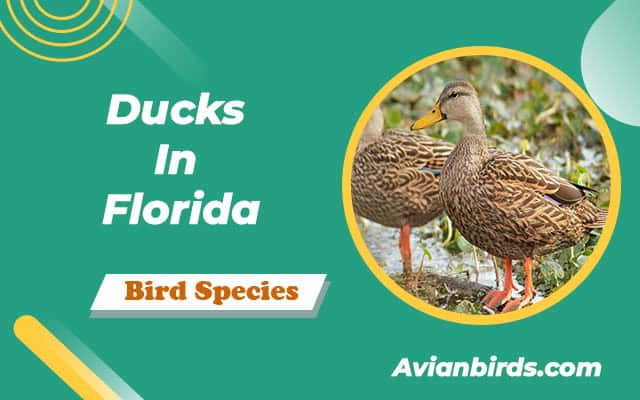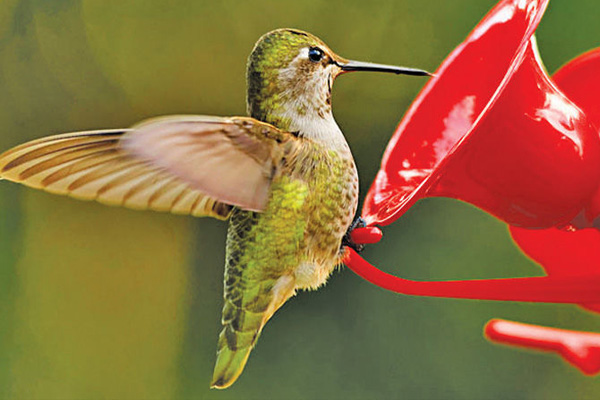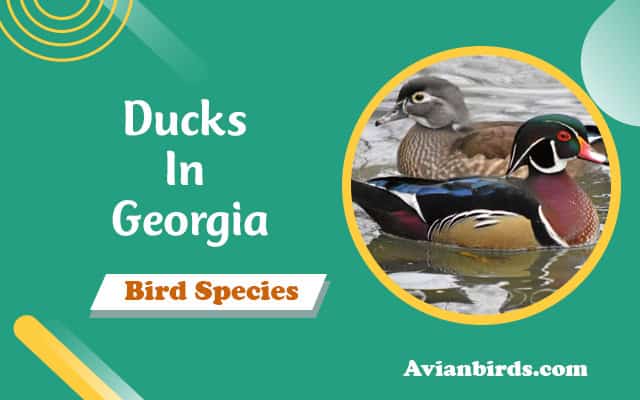10 Types Of Ducks Found In Florida (With Pictures)
Do you love Ducks in Florida? Ducks add a special touch to Florida’s bird life. Ever wondered how many duck species live here? Florida is home to 34 different duck species, offering a wide variety. From the well-known Mallard to the rare Ruddy Duck, each one adds its own charm to the state’s wetlands and coasts.
Let’s dive into the secrets of Florida’s ducks. We’ll look at 15 common and interesting duck species in the state. You’ll learn about their unique traits, where they live, and how they behave. This guide is perfect for bird lovers or anyone curious about Florida’s bird life.
Ducks In Florida
Florida is a paradise for bird lovers and nature fans. It’s home to many duck species. With 34 species, these waterfowl can be seen in different places like coasts, wetlands, lakes, and ponds.
Many ducks in Florida show clear differences between males and females. Males often have bright, detailed feathers. Females have duller colors. You can see these ducks all year, but some come to Florida in the winter.
Florida’s ducks are a treat for birdwatchers and nature lovers. You can see a variety of ducks in different places. Each duck has its own look and way of acting.
Common Duck Species in Florida
Some ducks you’ll often see in Florida include:
- Mallard Duck
- Ring-necked Duck
- Ruddy Duck
- Mottled Duck
- Wood Duck
- Northern Pintail
- Blue-winged Teal
- Green-winged Teal
- Northern Shoveler
- Black-bellied Whistling-duck
These ducks live in many places in Florida, like coastal marshes and wetlands. They also live in inland lakes and ponds. This gives birdwatchers and nature lovers lots of chances to see these amazing birds.
1. Mallard Duck
- Scientific name – Anas platyrhynchos
- Lifespan – 27 years (maximum recorded)
- Size – 19.7 to 25.6 in
- Weight – 26.5 to 56.4 oz
- Wingspan – 29.5 to 39.4 in
- Status – Least concern
The mallard duck is a common sight in Florida. It’s known for its unique colors and widespread presence. You can see these ducks in many places, like waterways, parks, and wetlands.

Description
Mallard ducks stand out because of their eye-catching look. Male mallards, or drakes, have a green head, a yellow beak, and a white collar. They also have a grey back, a white belly, a purply-brown breast, and a black lower back.
Their wings are grey with a blue speculum and a white border. The underwings are whitish.
Females are less colorful, with a brown coat and dark brown-edged feathers. They have a blue speculum with a white border too.
You can see mallards all year in many places, from city ponds to natural wetlands. Fort De Soto Park is a great spot to see them. Their presence makes the park even more beautiful.
“Mallard ducks are one of the most ubiquitous waterfowl species found across Florida.”
2. Ring-necked Duck
- Scientific name – Aythya collaris
- Lifespan – 20 years (maximum recorded)
- Size – 15.3 to 18.1 in
- Weight – 17.3 to 32.1 oz
- Wingspan – 24.4 to 24.8 in
- Status – Least concern
In Florida, the ring-necked duck is a common winter visitor. They can be seen in ponds, marshes, and lakes. Their numbers increase in the colder months, making them a highlight of the state’s waterfowl.

It’s easy to spot the ring-necked duck because of its unique look. Males have a black upper body, black breast, and a white crescent on their neck. Their heads shine, their flanks are grey, and their wing feathers are pale. Females have a dark brown back, light brown sides, and a white belly.
These ducks live in many water habitats, like ponds, marshes, lakes, rivers, and bays. The Merritt Island National Wildlife Refuge is a great place to see them. Their beauty adds to the area’s natural charm.
| Identification Feature | Male Ring-necked Duck | Female Ring-necked Duck |
|---|---|---|
| Upper Body | Black | Dark Brown |
| Breast | Black | Light Brown |
| Underparts | White | White |
| Head | Dark and Iridescent | Light Brown |
| Flanks | Greyish | Light Brown |
| Secondaries | Pale | Pale |
The ring-necked duck is a beautiful sight in Florida’s waters. Birdwatchers and nature lovers will enjoy seeing them. Keep an eye out for these ducks in places like the Merritt Island National Wildlife Refuge.
3. Ruddy Duck
- Scientific name – Oxyura jamaicensis
- Lifespan – 13 years (maximum recorded)
- Size – 13.8 to 16.9 in
- Weight – 10.6 to 30 oz
- Wingspan – 22.1 to 24.4 in
- Status – Least concern
In Florida, the ruddy duck is a common sight, especially during winter. Some stay all year. This duck stands out with its unique look.
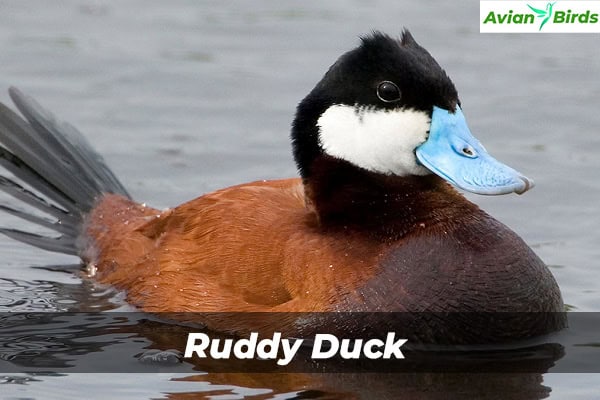
The male ruddy duck catches the eye with its chestnut body and black crown. It has a blue bill and white cheeks. The underside is chestnut with white streaks, and the underwings are white.
The female ruddy duck is less flashy but still beautiful. It has a brown body with rufous tints. It has a whitish head, a brown stripe on the head side, and a dark crown.
Everglades National Park is a great place to see ruddy ducks in Florida. They can be seen gliding on the water or diving for food.
The ruddy ducks are a joy to watch with their unique looks and behaviors. They add to Florida’s rich bird life. Birdwatchers and nature lovers will find them a highlight of their trip.
4. Mottled Duck
- Scientific name – Anas fulvigula
- Lifespan – 13 years (maximum recorded)
- Size – 18.5 to 22.5 in
- Weight – 24.7 to 43.8 oz
- Wingspan – 31.5 to 34.3 in
- Status – Least concern
The mottled duck is a common sight in Florida, staying all year round. Both males and females have a dark buff-brown body. They have pale buff heads and brown streaks on their backs and sides. Their crowns are dark brown, and a line through their eyes adds to their look.
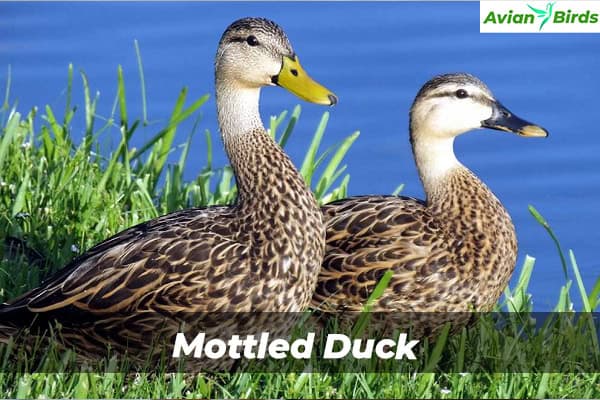
Their underwings are white, and the speculum, or wing patch, is a bright dark blue with a darker edge.
One way to tell males and females apart is by their beaks. Males have a yellow beak, while females have a black beak with an orange tip. Females are also a bit darker overall than males.
To see these unique ducks, head to the J.N. “Ding” Darling National Wildlife Refuge in Florida. This refuge is a great place for spotting mottled ducks. You might see them wading in shallow waters or resting on the shore.
| Characteristic | Male Mottled Duck | Female Mottled Duck |
|---|---|---|
| Beak Color | Yellow | Black with orange tip |
| Overall Plumage | Lighter buff-brown | Slightly darker buff-brown |
| Speculum | Dark blue with dark border | Dark blue with dark border |
5. Wood Duck
- Scientific name – Aix sponsa
- Lifespan – 22 years (maximum recorded)
- Size – 18.5 to 21.3 in
- Weight – 16 to 30.4 oz
- Wingspan – 26 to 28.7 in
- Status – Least concern
The wood duck is a stunning bird found in Florida’s wetlands and flooded woodlands all year. It has an iridescent green head, a chestnut chest, and bold markings. The male wood duck is a true showstopper with its unique look.
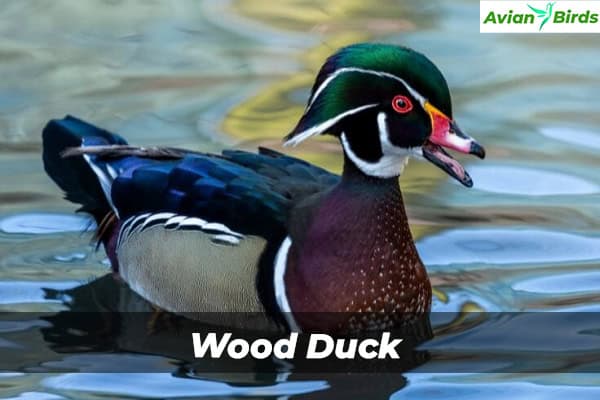
The female wood duck is also beautiful but more subdued in color. She has a greyish head with a white teardrop eye patch and a blue patch on her wing. Both the male and female wood ducks have a unique, slightly crested look.
You can spot wood ducks in various locations across the state. The Myakka River State Park is a great place to see them in the diverse wetland habitats. Wood ducks are a beloved and iconic part of Florida’s avian landscape.
| Feature | Male Wood Duck | Female Wood Duck |
|---|---|---|
| Head | Iridescent green, crested | Greyish, slightly crested |
| Chest | Chestnut | Brown |
| Belly and Throat | White | White |
| Flanks | Buff | Brown |
| Eye | Bright red | White teardrop patch |
| Bill | White and red | Brown |
| Wing Patch | Grey underwings | Blue patch |
The wood duck is a standout among Florida’s ducks. It captivates birdwatchers and nature lovers with its striking look. It’s a year-round sight in the state’s wetland habitats.
6. Northern Pintail
- Scientific name – Anas acuta
- Lifespan – 22 years (maximum recorded)
- Size – 20.1 to 29.9 in
- Weight – 17.6 to 51.1 oz
- Wingspan – 31.5 to 37.4 in
- Status – Least concern
The northern pintail is a common duck in Florida, especially from November to February. It’s known for its unique look, making it a hit with bird lovers and nature fans.

The male northern pintail has a dark brown head and neck with a white neckband. This band goes into the white breast and underside. Its body is mostly grey, with a green speculum and a white rear border. The tail and undertail feathers are dark, and the bill is light blue. Females are light brown with a tan head and feathers that mix dark and white.
These ducks live in various wetlands in Florida, like Saint Marks National Wildlife Refuge. They can be seen in lakes, estuaries, salt marshes, and bays. Their presence adds to the area’s bird diversity, making it a treat for visitors and locals.
| Identification Feature | Male Northern Pintail | Female Northern Pintail |
|---|---|---|
| Head | Dark brown | Tan-colored |
| Neck | Dark brown with white neckband | Tan-colored |
| Upper Body | Grey with green speculum and white rear border | Light brown with dark and white mottling |
| Tail | Long, tapering, and dark in color | Mottled dark and white |
| Bill | Light blue | Dark |
The northern pintail adds beauty to Florida’s bird life. It shows how rich and varied the state’s wetlands are. Whether you’re a birdwatcher or just enjoying nature, seeing this duck is unforgettable.
7. Blue-winged Teal
- Scientific name – Spatula discors
- Lifespan – 23 years (maximum recorded)
- Size – 14.2 to 16.1 in
- Weight – 8.1 to 19.2 oz
- Wingspan – 22.1 to 24.4 in
- Status – Least concern
The blue-winged teal is a common duck species in Florida. They can be seen all year but more in winter. These ducks are loved by birdwatchers and nature lovers for their unique looks and behaviors.

Male blue-winged teals stand out with their reddish-brown belly and breast. They also have delicate spots and a dark gray head with a black crown. The back and wings are dark brown with streaks, and they have a vibrant green speculum on their upper wing.
Females have a more subdued look with dark streaks on their heads and a brown crown. Their underparts are warm buff, and they also have a green speculum.
You can find these ducks in various wetlands in Florida, like the Saint Marks National Wildlife Refuge. They can be seen in marshes, ponds, or lakes. Spotting a blue-winged teal shows you the rich waterfowl life in Florida.
| Characteristic | Male Blue-winged Teal | Female Blue-winged Teal |
|---|---|---|
| Head | Dark gray with black crown | Brown with dark streaks |
| Belly and Flanks | Reddish-brown with spots | Buff |
| Wings | Dark brown with green speculum | Dark brown with green speculum |
Seeing the blue-winged teal is a treat for birdwatchers in Florida. Their bright colors and elegant moves make them a joy to watch in the wild.
“The blue-winged teal is one of the most widespread and abundant duck species in North America, and its presence in Florida is a testament to the state’s incredible avian diversity.”
8. Green-winged Teal
- Scientific name – Anas crecca
- Lifespan – 20 years (maximum recorded)
- Size – 12.2 to 15.3 in
- Weight – 4.9 to 17.6 oz
- Wingspan – 20.5 to 23.2 in
- Status – Least concern
If you’re into birdwatching in Florida, you’ll likely see the green-winged teal in winter. This small duck is a common sight in the Sunshine State. It brightens up the wetlands, marshes, bays, and rivers it lives in.
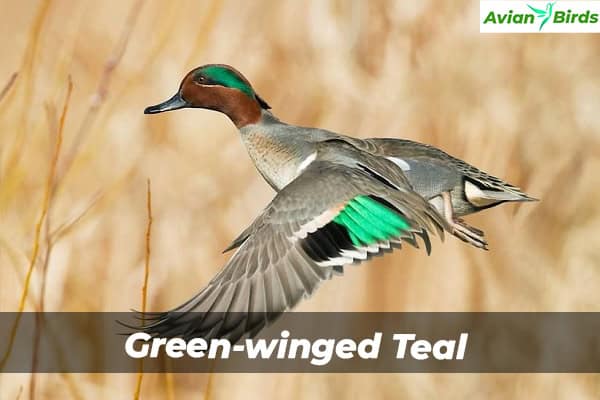
The male green-winged teal is a stunning sight. It has grey upperparts, a cinnamon-colored head, and a green band above the eye. Its breast is yellowish-white with brown spots. It also has a white line on each side and grey flanks and underwings.
The females are more subtle, with brown feathers. They have a light brown head and neck, a black stripe through the eye, and a whitish throat and underparts.
Myakka River State Park is a great place to see green-winged teals. These ducks can be found foraging and resting in the wetlands. They are small and agile, moving quickly through the water and taking off with speed.
Whether you’re a serious birdwatcher or just love Florida’s wildlife, the green-winged teal is a must-see. Its bright colors and interesting behavior make it a standout among Florida’s waterfowl.
9. Northern Shoveler
- Scientific name – Spatula clypeata
- Lifespan – 16 years (maximum recorded)
- Size – 17.3 to 20.1 in
- Weight – 14.1 to 28.9 oz
- Wingspan – 27.2 to 33.1 in
- Status – Least concern
The northern shoveler is a unique duck known for its large, shovel-like beak. These ducks are common in Florida all year but more so in winter. They can be seen in various places, like the Merritt Island National Wildlife Refuge.

Distinctive Features
The male northern shoveler stands out with its big, dark beak. This beak is one of the most recognizable traits of the species. Its eyes are often yellow or orange, and it sports a green head and black back.
It also has a greyish-blue shoulder patch, a green speculum, and a white stripe on the upper wing. The belly and flanks are chestnut-colored, the breast is white, and the vent is blackish.
The female northern shoveler looks different, being brown with dark spots and a blue wing patch. They live in wetlands like salt marshes, lakes, ponds, and estuaries. Places like the Merritt Island National Wildlife Refuge are good spots to see them.
- Distinctive large, shovel-like beak
- The male has a green head, black back, and chestnut-colored belly
- The female is brown with dark mottling and a blue wing patch
- Found in wetlands, salt marshes, lakes, and ponds across Florida
The northern shoveler’s big, unique beak makes it easy to spot in Florida. If you enjoy birdwatching or visiting wildlife refuges, look out for these striking ducks.
Check Our Previous Articles:
10. Black-bellied Whistling-duck
- Scientific name – Dendrocygna autumnalis
- Lifespan – 10 years (maximum recorded)
- Size – 18.5 to 22 in
- Weight – 23 to 36 oz
- Wingspan – 30 to 37 in
- Status – Least concern
The black-bellied whistling duck is a common sight in Florida. It’s easy to spot because of its brown upper parts and black belly. Both males and females look similar, making them fun to watch.

Look for the black-bellied whistling duck in the sky because of its white wing patch. Its upper neck and head are a lovely grey color. There’s a brown crown and a white eye ring that makes it stand out.
These black-bellied whistling ducks live in Florida all year, but you’ll see more of them in the summer. They like wetlands, marshes, and coastal areas. They add to Florida’s diverse bird life.
Frequently Asked Questions
Q1. What kind of ducks are there in Florida?
Florida is home to various ducks, including the Mallard, Mottled Duck, Black-bellied Whistling Duck, and Muscovy Duck.
Q2. Why are there so many Muscovy ducks in Florida?
Muscovy ducks are common in Florida because they were introduced from Central and South America and thrive in urban and suburban environments.
Q3. Is it legal to catch ducks in Florida?
Yes, it is legal to catch ducks in Florida, but you must have the proper hunting licenses and follow specific regulations and seasons.
Q4. How long do Florida ducks live?
Florida ducks can live anywhere from 5 to 10 years in the wild, depending on the species and environmental conditions.

